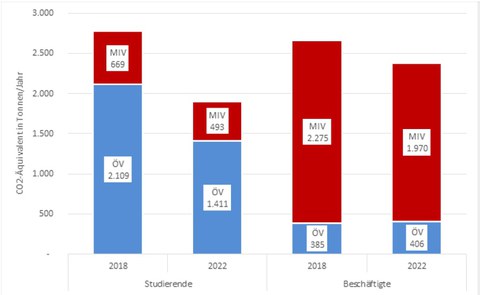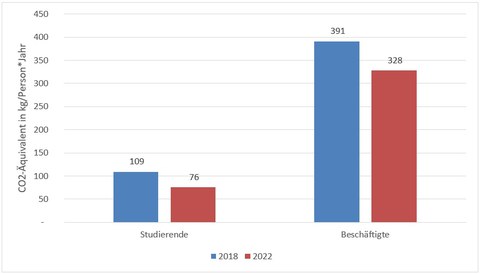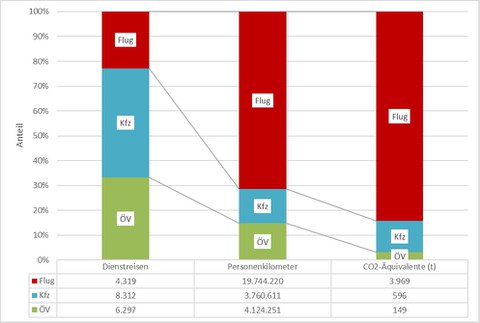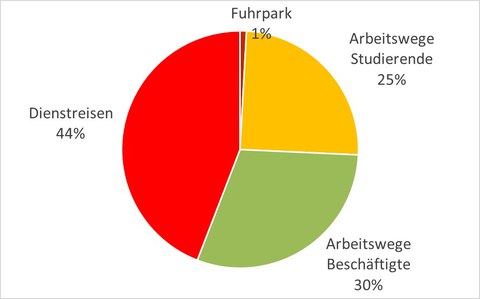Umweltauswirkungen und Maßnahmen für eine umweltfreundlichere Mobilität
Inhaltsverzeichnis
Wege der Hochschulangehörigen zum Arbeits- und Studienort
Täglich pendelt ein Großteil der fast 40.000 Hochschulangehörigen zwischen Wohnung und Arbeitsstätte bzw. Studienort. Die damit verbundenen Emissionen stellen eine wesentliche Umweltauswirkung der TU Dresden dar. Daher ist es wichtig, Maßnahmen zu ergreifen, um diese Wege möglichst umweltfreundlich zurückzulegen. Hierzu gehören z. B. die Verbesserung der Konditionen des Jobtickets für Beschäftigte, der Erhalt des Semestertickets für Studierende, Verbesserungen für Radfahrende oder die Unterstützung von Pendler-Mitfahrgemeinschaften.
Der Modal Split, d.h. welches Verkehrsmittel für den Weg zum Arbeits- oder Studienort gewählt wird, wurde in den vergangenen Jahren in mehreren Befragungen ermittelt, zuletzt durch die Mobilitätsbefragung 2022.

Absolute CO2-Äquivalentemissionen der Studierenden und Beschäftigten auf dem Weg von und zur TUD in den Jahren 2018 und 2022
Im Rahmen des Projektes CAMPER-MOVE wurden die CO2-Emissionen der Wege zur TU Dresden auf der Grundlage der Mobilitätsbefragungen 2018 und 2022 bilanziert. Da die medizinische Fakultät nicht an den Mobilitätsbefragungen beteiligt war, wurde diese auch bei den CO2-Berechnungen nicht berücksichtigt. Die Berechnungen zeigten, dass die ca. 25.400 Studierenden im Jahr 2018 in der Summe auf ihren Wegen zur Uni ähnlich viel CO2 emittierten wie die ca. 6.800 Beschäftigten.
Im Jahr 2022 sind die Emissionen bei beiden Gruppen deutlich zurückgegangen. Folgende Gründe können dafür benannt werden:
Studierende:
- Leicht zurückgegangene Studierendenzahlen (25.400 auf 25.200)
- Verschiebung von motorisierten Wegen (MIV+ÖV) zu nichtmotorisierten Wegen (Rad+Fuß)
- Rückläufige Anwesenheit auf dem Campus durch Online-Angebote
Beschäftigte:
- Leicht steigende Beschäftigtenzahl (6.800 auf 7.200)
- Verschiebung des Modal Split vom MIV zum Radverkehr
- Rückläufige Anwesenheit auf dem Campus durch Homeoffice
Neben der Wirkung von bereits umgesetzten Maßnahmen sind diese Entwicklungen stark von der COVID 19-Pandemie beeinflusst. Zum Zeitpunkt der Befragung 2022 waren bis auf die Maskenpflicht im ÖV allerdings die meisten Einschränkungen im öffentlichen Leben aufgehoben. Man kann also davon ausgehen, dass gewisse Veränderungen, wie die Nutzung von Homeoffice und Online-Lehre, sowie die verstärkte Nutzung des Fahrrades auch nach der Pandemie dauerhaft erhalten bleiben. Weitere Informationen dazu im Bereich Mobilitätsbefragung.

Spezifische CO2-Äquivalentemissionen der Studierenden und Beschäftigten auf dem Weg von und zur TUD in den Jahren 2018 und 2022 (jährliche Emissionen pro Person)
Berechnet man aus diesen Zahlen die spezifischen CO2-Äquivalentemissionen der Studierenden und Beschäftigten, also die Werte pro Person und Jahr, dann sind die Zahlen für beide Gruppen seit 2018 rückläufig. Es ist auch ersichtlich, dass die Beschäftigten aufgrund des höheren Autoanteils die vierfachen Pro-Kopf-Emissionen der Studierenden verursachen und mit 328 kg im Jahr schon etwa ein Drittel des langfristigen CO2-Zielwertes von einer Tonne CO2 pro Person und Jahr nur beim Arbeitsweg freisetzen.
Für den Hauptcampus der TU Dresden wurde an der Professur für Mobilitätssystemplanung ein fachlich orientiertes Mobilitätskonzept erarbeitet. Es beinhaltet die folgenden Maßnahmenpakete:
- Verantwortungsbewusstes Parkraummanagement
- Attraktiver ÖPNV als Rückgrat der Campusmobilität
- Qualitätsoffensive Radverkehr
- Erhöhung der Aufenthaltsqualität
- Ausbau der innovativen Mobilitätsangebote
- Etablierung einer verkehrssparsamen Mobilitätskultur
- Nachhaltiges Dienstreisemanagement
Die Mobilitätsvision besteht in einem sehr gut erreichbaren, lebendigen, nachhaltigen und innovativen TU-Campus mit einer hohen Aufenthaltsqualität.
Dienstreisen der Hochschulangehörigen
Im Folgenden geht es um die Frage, wie hoch die Treibhausgasemissionen sind, die an der TU Dresden durch Dienstreisen entstehen. Welche Maßnahmen können zu einer Reduktion der Treibhausgasemissionen beitragen?
Für die Auswertung der Dienstreisen der TU Dresden konnte 2017 im Rahmen des Projektes HochN auf die elektronischen Daten der Reisekostenstelle zurückgegriffen werden. Die Analyse der an der TU Dresden durchgeführten Dienstreisen im Jahre 2016 ergab, dass bei den ca. 19.000 abgerechneten Dienstreisen etwa 27,6 Millionen Personenkilometer zurückgelegt wurden und ca. 4.700 Tonnen CO2 emittiert wurden.

Anzahl der Dienstreisen, Personenkilometer und CO2 Emissionen (Auswertung der Dienstreisedaten 2016)
Von den Dienstreisen wurden 44% mit dem Pkw, 28% mit der Bahn, 23% mit dem Flugzeug, 3% mit dem ÖPNV, 2% mit dem Fernbus und 0,3% mit dem Fahrrad durchgeführt. Markant ist dabei, dass im Rahmen der 23% Flugreisen 71% der Personenkilometer zurückgelegt wurden und 84% der CO2-Äquivalentemissionen freigesetzt wurden.

Prozentuale Verteilung der CO2-Äquivalentemissionen durch Mobilität an der TU Dresden (Stand 2017)
Insgesamt sind die Dienstreisen damit Ursache für 44% der mobilitätsbedingten CO2-Äquivalent-Emissionen der TU Dresden, wobei allein die dienstlichen Flugreisen für 37% der mobilitätsbedingten CO2-Äquivalent-Emissionen der TU Dresden verantwortlich sind.
Als alternative Möglichkeit zur Dienstreise wurden schon in der Vergangenheit oft moderne Kommunikationstechnologien für Webkonferenzen oder virtuelle Meetings genannt. Statistische Daten zeigten allerdings, dass trotz steigender Anzahl virtueller Meetings parallel auch die Verkehrsleistung bei Dienstreisen stark stieg. Dabei wurde sogar der Zusammenhang vermutet, dass gerade diese Kommunikationstechnologien die Globalisierung von Wissenschaft und Lehre vorantreiben und somit bei dynamischer Betrachtung zum langfristigen Anwachsen der Verkehrsleistungen beitragen. Virtuelle Meetings machen eine Projektzusammenarbeit zwischen räumlich weit entfernten Hochschulen und anderen Partnern möglich, die komplette Bearbeitung von Projekten ohne persönliche Treffen zum Projektbeginn und –abschluss ist dabei eher selten. Eine einzelne Flugreise beispielsweise in die USA kann aber in ihrer Klimawirkung diejenige von regelmäßigen Fahrten zu innerdeutschen Zielen um ein Vielfaches übertreffen.
Mit der Corona-Pandemie 2020 änderte sich das allerdings. Da Dienstreisen nur noch eingeschränkt oder gar nicht mehr möglich waren, übernahmen Webkonferenzen einen großen Teil des nationalen und internationalen Austausches. Viele Wissenschaftler:innen, die jetzt zur Nutzung der Webkonferenzen gezwungen waren, stellten fest, dass diese zwar kein vollständiger Ersatz realer Meetings sind, aber auch einige erhebliche Vorteile besitzen. Die intensive globale Nutzung der Systeme führte zudem in kurzer Zeit zu deren technischer Verbesserung. Es bleibt abzuwarten, was nach der Corona-Pandemie passiert. Werden viele verschobene Dienstreisen nachgeholt und es gibt einen Dienstreiseboom - oder bleibt ein Teil der ersetzten Dienstreisen dauerhaft bei den Webkonferenzen?
Derzeit gibt es verschiedene Überlegungen über Ansätze zur Reduzierung der dienstreisebedingten Emissionen. In der Diskussion sind:
- Maßnahmen zur Entwicklung eines entsprechenden Bewusstseins bei den Entscheidungsträger:innen für die Beantragung und Genehmigung von Dienstreisen
- Vermittlung von Wissen über die unterschiedlichen Umweltwirkungen der einzelnen Verkehrsmittel
- Selbstverpflichtung zum Verzicht auf Kurzstreckenflüge
- Entwicklung von Leitlinien für umweltfreundliche Dienstreisen
- Verlagerung auf umweltfreundlichere Verkehrsmittel
Auch die umstrittene CO2-Kompensation der Flugreisen ist in der Diskussion.
Um tatsächliche Minderungen zu erreichen, ist die Definition von spezifischen Minderungszielen (Verbräuche + Emissionen/Beschäftigten) und absoluten Minderungszielen (Verbräuche/Emissionen gesamt) unerlässlich. Um den Stand bezüglich der Zielerreichung zu kontrollieren, ist die regelmäßige Bilanzierung der CO2-Emissionen der Dienstreisen zwingend erforderlich. Im Rahmen des Projektes CAMPER-MOVE wird deshalb angestrebt, eine jährliche Bilanzierung der Verkehrsmittelverteilung, Verkehrsleistung und der CO2-Emissionen der Dienstreisen in einem Monitoringsystem zu installieren. Auf diesen Informationen aufbauend kann dann jährlich über Zielerreichung oder weiteren Handlungsbedarf entschieden werden.
